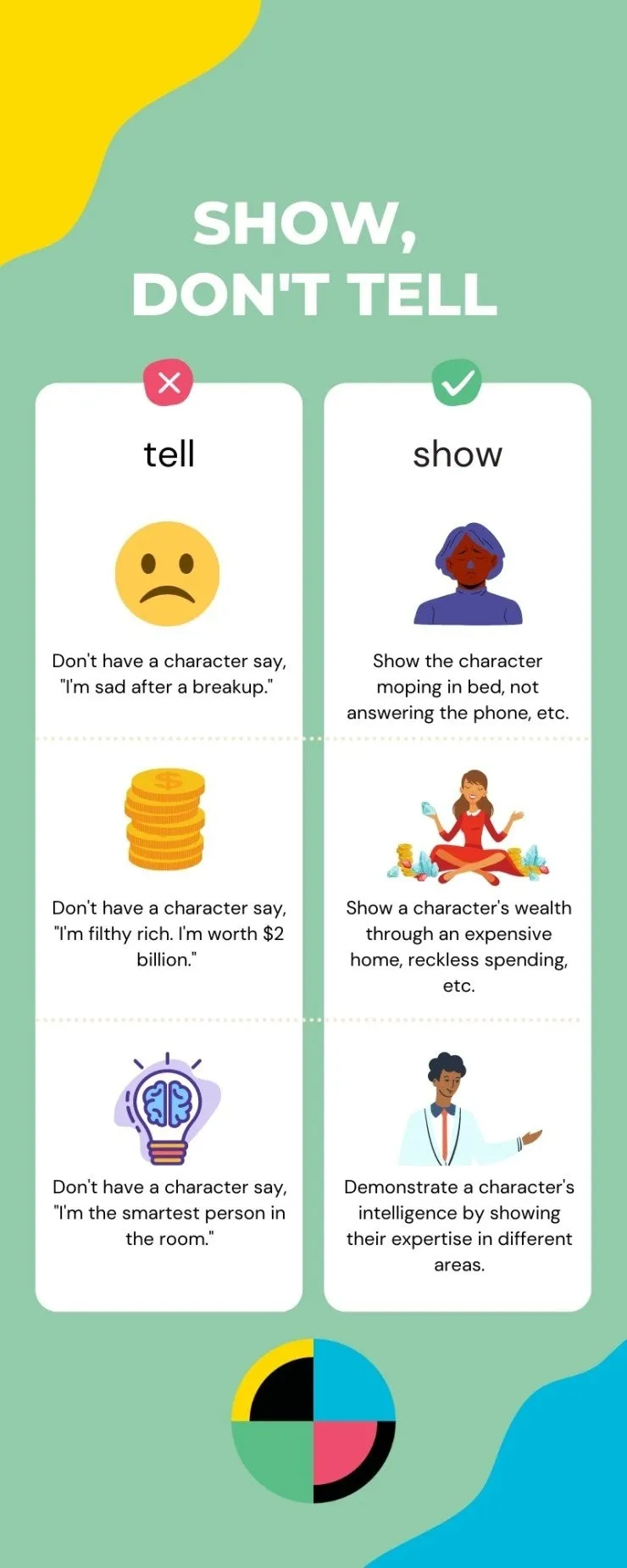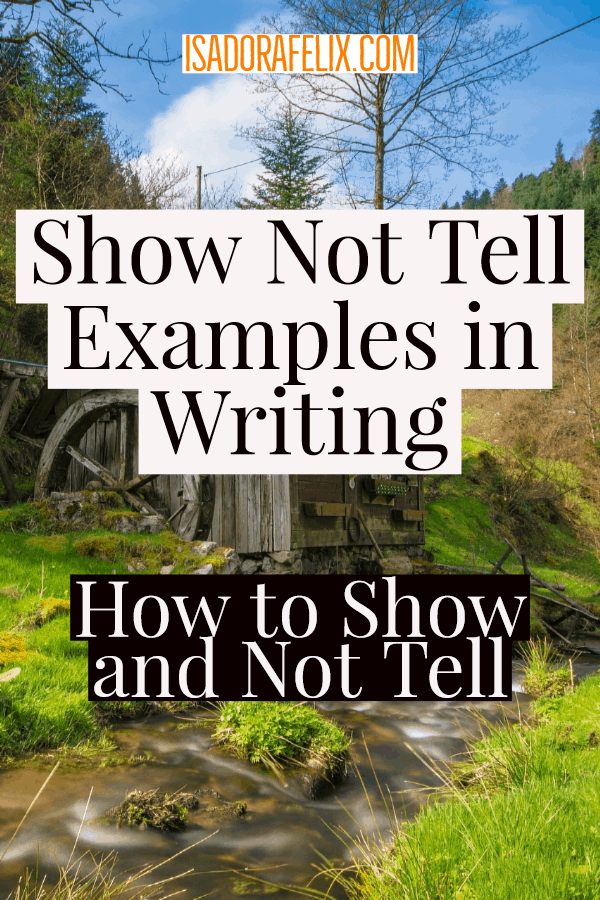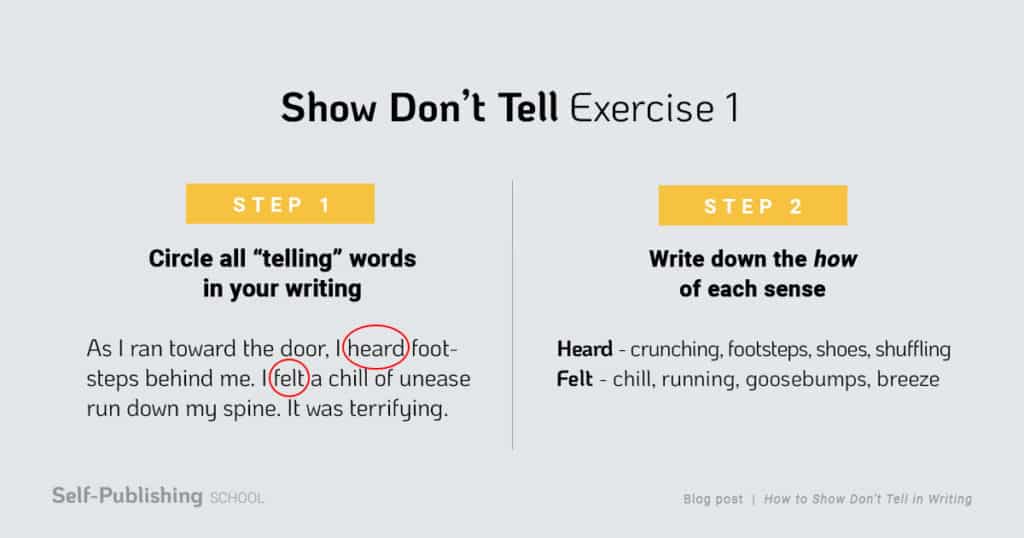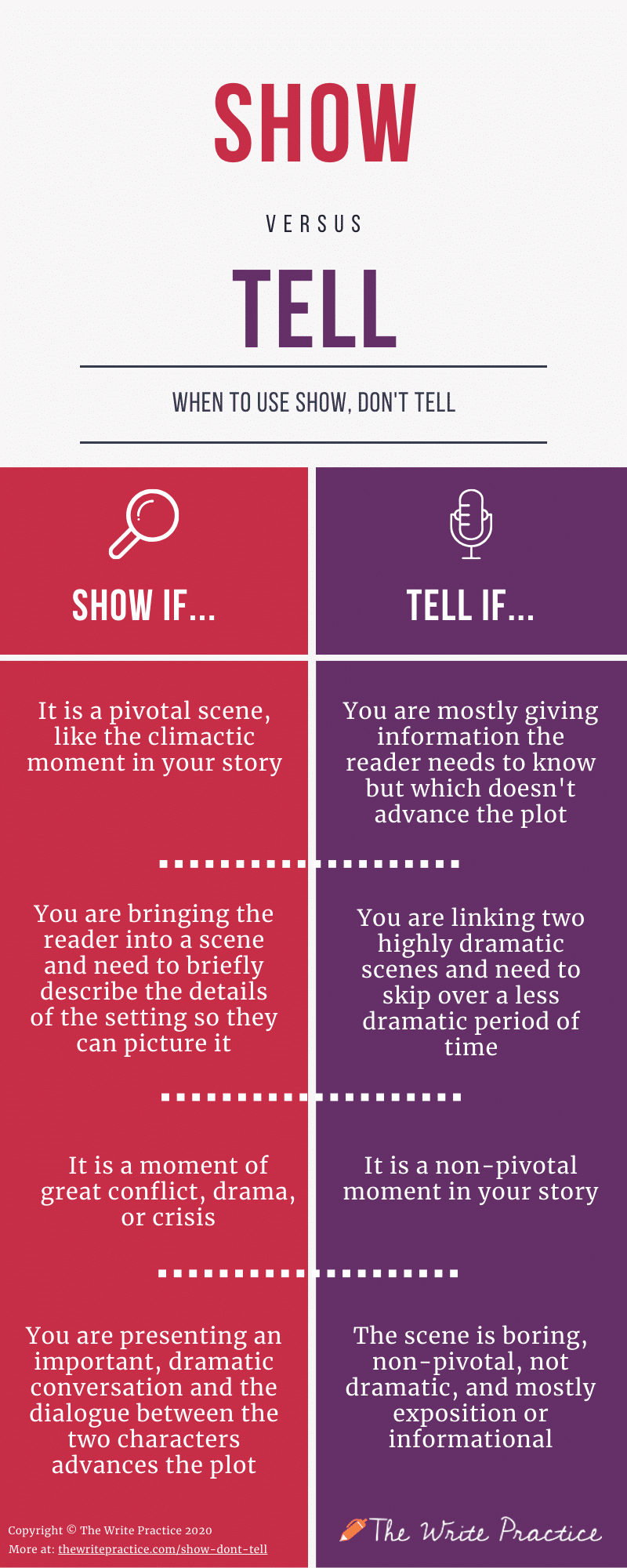
How to "Show, Don't Tell"—Examples and Definition in Film and Television
The Difference Between Showing and Telling. "Show, don't tell" means you must demonstrate action through your writing instead of having a narrator just talk about action. When you tell the reader that your protagonist is strong, brave, and intelligent, that's telling, and too much telling makes for very boring reading.

SHOW ME, DON'T TELL ME SHOW, NOT TELL TECHNIQUE
Telling: She was hungry. Showing: Her stomach tied itself in knots and reached through her throat to grab the aroma of breakfast at grandma's house - buttery eggs mixed with bacon grease and sticky-sweet syrup on stacks of pancakes. She tried to remember the last time she'd eaten that day.

Writing Tips Show Don’t Tell
Sol Stein, On Writing In his book, Stein On Writing, Sol Stein provides a very helpful guide on something writers so often hear about: show, don't tell. The quote above neatly sums up the difference between the two approaches. Do you remember asking someone, a family member perhaps, to tell you a story?

Show, Don’t Tell What It Is and How to Use It (With Examples) All Write Alright
"Show, don't tell" is a popular piece of creative writing advice to write with more sensory details, allowing your reader to hear, see, taste, touch, and smell the same things your fictional characters experience.

Show Don't Tell Anchor Chart! This blog post contains a complete writing lesson and the
The best examples of "Show, don't tell" come from thrillers and crime movies, I think. The reason is that we usually see police or detectives gathering clues as they go. In something like Knives Out, we see its lead detective gathering clues the whole movie. Sure, at the end he tells us what they all mean, but up until then, we're just showing.

Show Not Tell Examples in Writing How to Show and Not Tell
"Show, Don't Tell" is an immersive method of writing in which characters and story are related using sensory details and actions. The point of "showing" is to pull the reader into a story by engaging all five of their senses.

Show Don't Tell How to Show Not Tell in Your Writing
T hese examples of "Show Don't Tell" will inspire you to tell better stories by directing a mental movie in your readers' minds. This article includes: What is "Show Don't Tell?" A "Show Don't Tell" exercise 21 "Show Don't Tell" examples How to show AND tell How to apply "Show Don't Tell" Show, Don't Tell Helen frowns while reading her draft story.

Show, Don't Tell Writing lessons, Teaching writing, Classroom writing
Examples of Show Don't Tell What Does Show Don't Tell Mean? "Show, don't tell" is a writing technique that allows the reader to experience expository details of the story through actions, sensory details, words, or the expression of characters' emotions, as opposed to through the author's own description of events.

Show Not Tell resource sheet Teaching Resources
Mad Max: Fury Road is likely the most mentioned movie when it comes to stellar examples of the writing technique. "Not sure if it's my favorite but definitely one I think fits the bill," u.

Show Don't Tell Mini Writing Anchor Charts Show dont tell, Writing lessons, English lessons
Show don't tell describes writing in various forms with an emphasis on using and showing actions in order to convey the emotions you want readers to interpret, which creates a better experience for readers, instead of writing exposition to tell what happened.

Show, Don't Tell Comparison (Beth Newingham) Writing lessons, Teaching writing, Descriptive
Show, don't tell: 6 tips for getting it right. 1. Engage the senses. Show, don't tell means giving readers all of the sensory information they need to experience a story as your characters do. So include lots of sensory description. Tell a reader what your characters are seeing, smelling, tasting, hearing and feeling.

Writing SHOW don't tell. Literacy Coaching, Teaching Literacy, Teaching Writing, Writing
This example gives us useful show don't tell tips: Telling has its place - use it to give the reader secondary information such as how a character gets from A to B. Unless something crucial happens to your character during her journey, the reader doesn't need every detail of her commute. Keep the detail of showing for scenes that deepen.

Show Not Tell writing anchor chart Writing anchor charts, Writing lessons, Writing skills
No nothing. You are simply stating a fact from your story. As showing would be: "Blake got into the school hall and sighed loudly. He would rather be anywhere in the world but there. He walked towards his lockers but felt someone pushing him, so he was thrown onto the hard floor. He hit his chest and it hurt so much, that tears got into his eyes.

Show, Don't Tell The Secret to Great Writing with Show and Tell Examples
6 Examples of "Show, Don't Tell" What is "Show, Don't Tell?" "Show, don't tell" is often uttered by teachers and editors alike, but what exactly does it mean? Basically, "showing" and "telling" are two different writing techniques. Telling is the act of describing an action, setting, object, person, or other element in the story objectively.

Show Don't Tell Writing for PROMETHEAN Board in 2021 Show dont tell, Teaching writing
Here's a quick example: Showing: As his mother switched off the light and left the room, Michael tensed. He huddled under the covers, gripped the sheets, and held his breath as the wind brushed past the curtain. Telling: Michael was terribly afraid of the dark.

Using Show not Tell in Writing; Complete Lesson Mr Stink Writing Similes, Persuasive Writing
So, do not use adverbs; replace them with the impact of those adverbs. #5. Avoid 'Telling' Verbs. If you want to follow the 'show don't tell' rule, avoid using the telling verbs like wondered, smelled, saw, thought, heard. These are telling verbs that put the reader out of a character's experiences. #6.